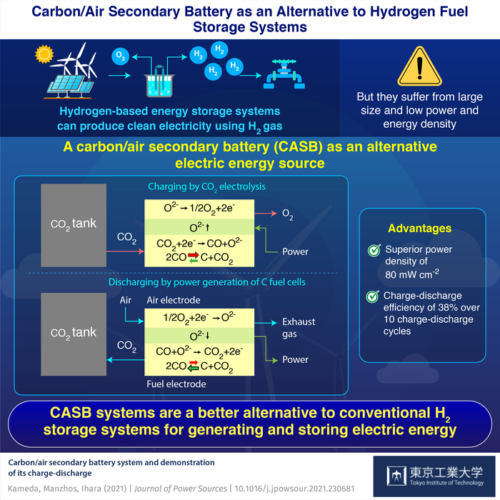
Detailed in Journal of Power Sources, the CASB is said to consist of a solid-oxide fuel and electrolysis cell (SOFC/ECs) where carbon generated via electrolysis of CO2 is oxidsed with air to produce energy. The SOFC/ECs can be supplied with compressed liquefied CO2 to make up the energy storage system, the team said.
“Similar to a battery, the CASB is charged using the energy generated by the renewable sources to reduce CO2 to C. During the subsequent discharge phase, the C is oxidised to generate energy,” said Prof. Manabu Ihara from Tokyo Tech.
MORE FROM ENERGY & ENVIRONMENT
As the carbon is stored in a confined space in the SOFCs/ECs, the energy density of the CASB is limited by the amount of carbon it can hold. Despite this, the researchers found that the CASB had a higher volumetric energy density compared to hydrogen storage systems.
During charge-discharge experiments the team observed that the transformations between C and CO2 were due to Boudouard reactions characterised by a redox reaction of a mixture of carbon monoxide (CO), CO2 and C. Specifically, during the charging phase, C was deposited on the electrode via the electrochemical reduction of CO2 and the reduction of CO via the Boudouard decomposition. During the discharge phase, the C was oxidised to CO and CO2 via the Boudouard gasification reaction and electrochemical oxidation respectively. The researchers found that the C utilisation for energy generation of the CASB depended on the equilibrium between C, CO2, CO, which is known as the Boudouard equilibrium.
According to Tokyo Tech, the CASB system utilised most of the carbon deposited on the electrode for energy generation, demonstrating a Coulombic efficiency of 84 per cent, indicating that most of the stored energy can be obtained during the discharge phase. It also showed power density of 80mW/cm2 and a charge-discharge efficiency of 38 per cent that was sustained over 10 charge-discharge cycles. This suggested that no degradation of the fuel electrode occurred.
“Compared to hydrogen storage systems, the CASB system is expected to have a smaller system size and higher system efficiency”, said Prof Ihara. Their new system could lay the foundation for compact and efficient carbon energy storage systems that could work alongside renewable energy sources, the team added.











McMurtry Spéirling defies gravity using fan downforce
Ground effect fans were banned from competitive motorsport from the end of the 1978 season following the introduction of Gordon Murray's Brabham...